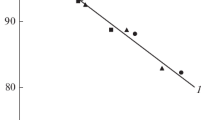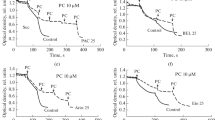Abstract
The effect of palmitic acid on glycerol-3-phosphate oxidation, i.e., on the glycerol-3-phosphate oxidase (GP oxidase) activity of liver mitochondria was investigated in the presence and absence of ATP, as well as under conditions of tert-butylhydroperoxide (TBH)-induced oxidative stress. It was found that palmitic and lauric acids inhibit GP oxidase activity of deenergized liver mitochondria formally in the competitive manner. In this case lauric acid, which is less hydrophobic than palmitic acid, inhibits GP oxidase activity of mitochondria significantly weaker. It is noted that the competitive inhibition of mitochondrial GP oxidase activity by these saturated fatty acids may be related to their ability, as amphiphilic compounds, to increase the negative charge density on the outer surface of the inner mitochondrial membrane. It is shown that ATP at a concentration of 2 mM eliminates the ability of palmitic acid to inhibit GP oxidase activity of mitochondria. This effect of ATP is not observed in the presence of F O F 1-ATP synthase inhibitor oligomycin. Apparently, in the case of vector transport of H+ from the matrix to the intermembrane space of mitochondria induced by ATP hydrolysis there is occurs protonation of palmitic acid anions on the outer surface of the inner membrane and subsequent movement of its neutral molecules to the inner monolayer of the inner membrane. It was found that TBH at a concentration of 300 µM in the presence of ATP and palmitic acid inhibits their GP oxidase activity formally in the competitive manner without significant effect on ATPase activity of liver mitochondria. Thiourea antioxidant eliminates this effect of TBH. It is assumed that TBH-induced oxidative stress in the case of ATP-energized mitochondria results in an increase in transport rate of palmitic acid anions from the inner monolayer of the inner membrane to its outer monolayer. This, in turn, is accompanied by an increase in the density of negative charges on the outer surface of the inner mitochondrial membrane and inhibition of GP oxidase activity of liver mitochondrial formally in the competitive manner.
Similar content being viewed by others
References
Mráček T., Drahota Z., Houštěk J. 2013. The function and the role of the mitochondrial glycerol-3-phosphate dehydrogenase in mammalian tissues. Biochim. Biophys. Acta. 1827, 401–410.
Garrib A., McMurray W.C. 1986. Purification and characterization of glycerol-3-phosphate dehydrogenase (flavin-linked) from rat liver mitochondria. J. Biol. Chem. 261, 8042–8048.
Mráček T., Holzerová E., Drahota Z., Kovářová N., Vrbacký M., Ješina P., Houštěk J. 2014. ROS generation and multiple forms of mammalian mitochondrial glycerol-3-phosphate dehydrogenase. Biochim Biophys Acta. 1837, 98–111.
Wojtczak L., Nalecz M.J. 1979. Surface charge of biological membranes as a possible regulator of membrane-bound enzymes. Eur. J. Biochem. 94, 99–107.
Denton R.M. 2009. Regulation of mitochondrial dehydrogenases by calciumions. Biochim. Biophys. Acta. 1787, 1309–1316.
Amler E., Rauchová H., Svobodová J., Drahota Z. 1986. Regulation of glycerol-3-phosphate oxidation in mitochondria by changes in membrane microviscosity. FEBS Lett. 206, 1–3.
Girotti A.W. 1998. Lipid hydroperoxide generation, turnover, and effector action in biological systems. J. Lipid Res. 39, 1529–1542.
Skulachev V.P., Bogachev A.V., Kasparinsky F.O. 2010. Membrannaja bioenergetika (Membrane bioenergetics). Moscow, Moscow University Press.
Zorov D.B., Juhaszova M., Sollott S.J. 2014. Mitochondrial reactive oxygen species (ROS) and ROSinduced ROS release. Physiol. Rev. 94, 909–950.
Eremeev S.A., Motovilov K.A., Volkov E.M., Yaguzhinskii L.S. 2011. The new member of the class of membranotropic uncouplers–SkQ3. Biol. Membrany (Rus.). 28, 339–344.
Isaev N.K., Novikova S.V., Stelmashook E.V., Barskov I.V., Silachev D.N., Khaspekov L.G., Skulachev V.P., Zorov D.B. 2012. Mitochondria-targeted plastoquinone antioxidant SkQR1 decreases trauma-induced neurological deficit in rat. Biokhimia. (Rus.). 77, 1201–1206.
Plotnikov E.Y., Morosanova M.A., Pevzner I.B., Zorova L.D., Manskikh V.N., Pulkova N.V., Galkina S.I., Skulachev V.P., Zorov D.B. 2013. Protective effect of mitochondria-targeted antioxidants in an acute bacterial infection. Proc. Natl. Acad. Sci. USA. 110, E3100–E3108.
Samartsev V.N., Smirnov A.V., Zeldi I.P., Markova O.V., Mokhova E.N., Skulachev V.P. 1997. Involved of aspartate/glutamate antiporter in fatty acid-induced uncoupling of liver mitochondria. Biochim. Biophys. Acta. 1339, 251–257.
Samartsev V.N., Kozhina O.V. 2008. Oxidative stress as regulatory factor for fatty-acid-induced uncoupling involving liver mitochondrial ADP/ATP and aspartate/glutamate antiporters of old rats. Biokhimia. (Rus.). 73, 972–980.
Kozhina O.V., Samartsev V.N. 2010. Uncoupling activity of fatty acids in liver mitochondria in the presence of substrates of ADP/ATP and aspartate/glutamate antiporters is increased under oxidative stress. Biol. Membrany (Rus.). 27, 184–188.
Chinopoulos C., Adam-Vizi V. 2010. Mitochondria as ATP consumers in cellular pathology. Biochim. Biophys. Acta. 1802, 221–227.
Kamo N., Muratsugu M., Hondoh R., Kobatake Y. 1979. Membrane potential of mitochondria measured with an electrode sensitive to tetraphenylphosphonium and reationship between proton electrochemical potential and phosphorylation potential in steady state. J. Membr. Biol. 49, 105–121.
Mitchell P., Moyle J. 1970. Influence of aurovertin on affinity of mitochondrial adenosine triphosphatase for ATP and ADP. FEBS Lett. 25, 309–311.
Wojtczak L., Schönfeld P. 1993. Effect of fatty acids on energy coupling processes in mitochondria. Biochim. Biophys. Acta. 1183, 41–57.
Samartsev V.N., Rybakova S.R., Dubinin M.V. 2013. Interaction of free fatty acids with mitochondria during uncoupling of oxidative phosphorylation. Biofizika (Rus.). 58, 481–487.
Benz R., McLaughlin S. 1983. The molecular mechanisms of action of the proton ionophore FCCP (carbonylcyanide p-triflurometoxy phenylhydrozone). Biophys. J. 41, 381–398.
Azzu V., Parker N., Brand M.D. 2008. High membrane potential promotes alkenal-induced mitochondrial uncoupling and influences adenine nucleotide translocase conformation. Biochem. J. 413, 323–332.
Haynes R.C. Jr, Picking R.A. 1984. The interaction of glucagon treatment and uncoupler concentration on ATPase activity of rat liver mitochondria. J. Biol. Chem. 259, 13228–13234.
Veech R.L., Lawson J.W., Cornell N.W., Krebs H.A. 1979. Cytosolic phosphorylation potential. J. Biol. Chem. 254, 6538–6547.
Brand M.D., Lehninger A.L. 1977. H+/ATP ratio during ATP hydrolysis by mitochondria: Modification of the chemiosmotic theory. Proc. Natl. Acad. Sci. USA. 74, 1955–1959.
Kozhina O.V., Stepanova L.A., Samartsev V.N. 2007. Peculiarities of the uncoupling action of fatty acids in liver mitochondria under oxidative stress. Biol. Membrany (Rus.). 24, 421–429.
Ježek J., Jabůrek M., Zelenka J., Ježek P. 2010. Mitochondrial phospholipase A2 activated by reactive oxygen species in heart mitochondria induces mild uncoupling. Physiol. Res. 59, 737–747.
Author information
Authors and Affiliations
Corresponding author
Additional information
Original Russian Text © V.N. Samartsev, M.V. Dubinin, O.E. Krasnoshchekova, 2015, published in Biologicheskie Membrany, 2015, Vol. 32, No. 3, pp. 185–193.
Rights and permissions
About this article
Cite this article
Samartsev, V.N., Dubinin, M.V. & Krasnoshchekova, O.E. Features of inhibition of glycerol-3-phosphate oxidase activity of liver mitochondria by palmitic acid in the presence of ATP and tert-butylhydroperoxide. Biochem. Moscow Suppl. Ser. A 9, 210–217 (2015). https://doi.org/10.1134/S1990747815020178
Received:
Published:
Issue Date:
DOI: https://doi.org/10.1134/S1990747815020178




